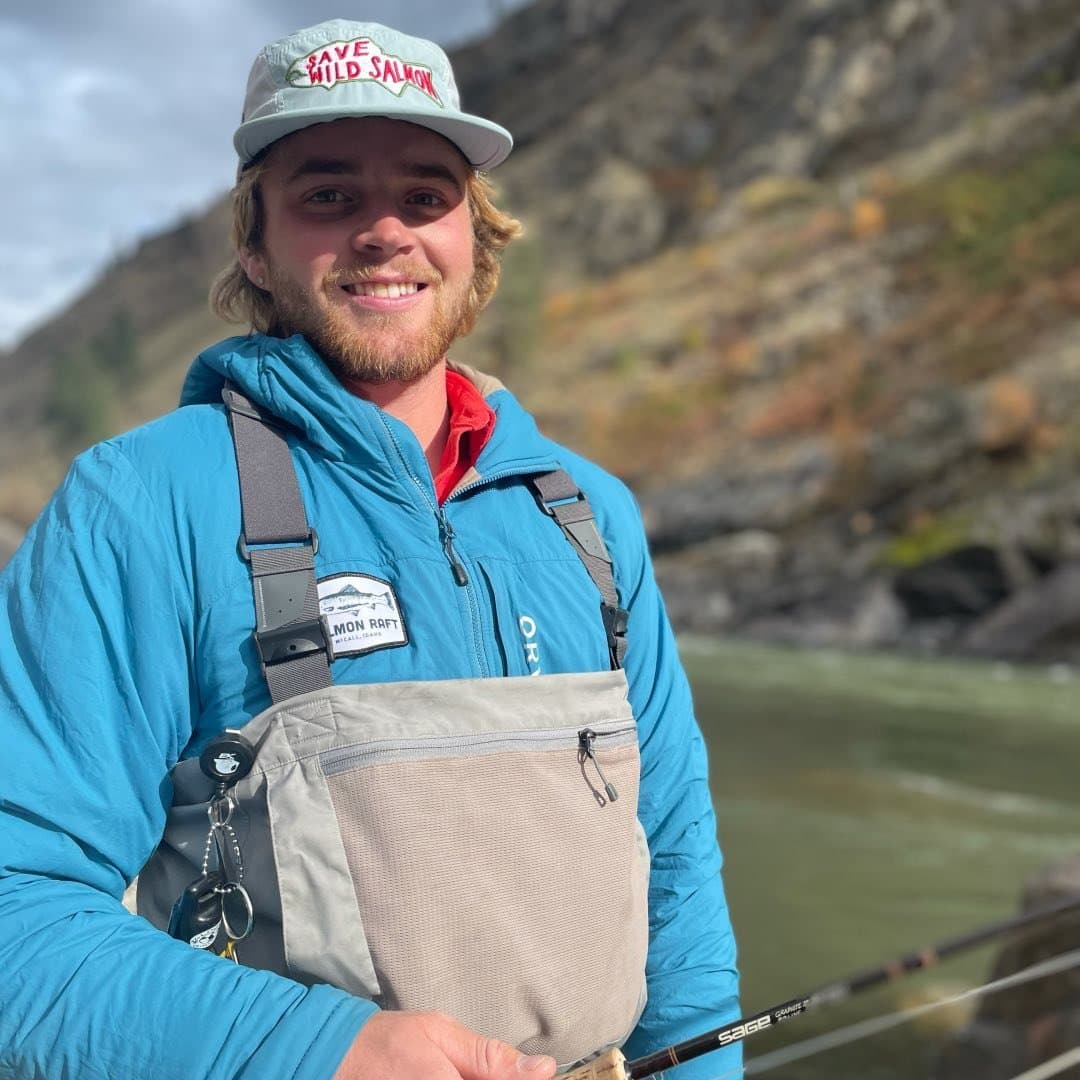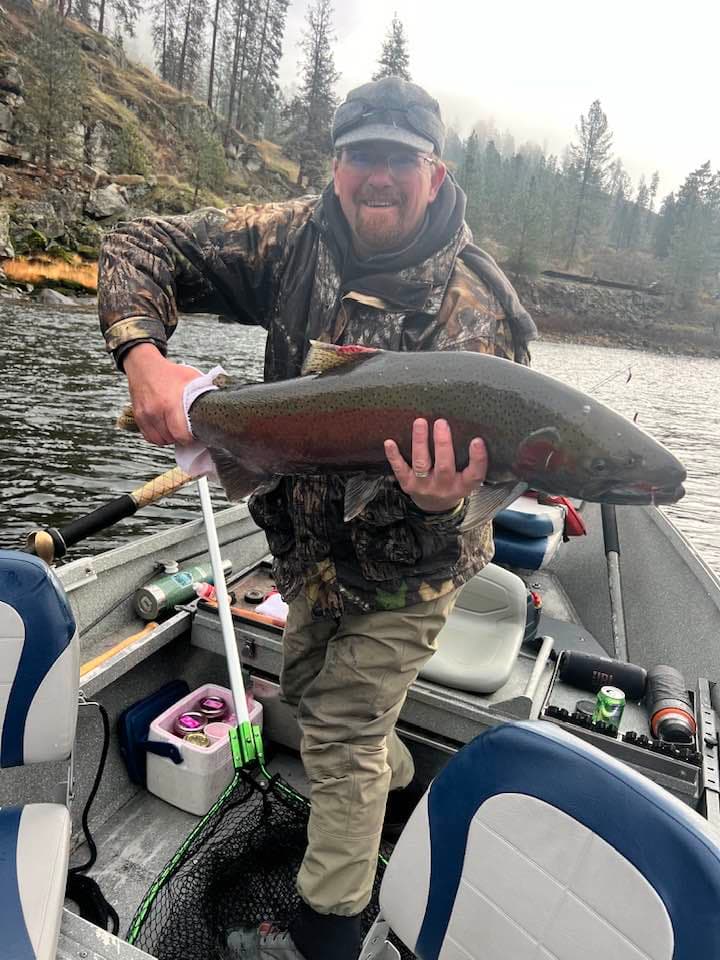Jack Hurty – IOGA’s new voice for salmon and steelhead
The Salmon River has a way of captivating people by all of its goodness and ecological riches, the sheer majesty of it all, especially the ocean-going fish, our imperiled Chinook salmon and steelhead runs.
 Boise native Jack Hurty has spent the last five years guiding trips on the Lower Salmon River, the Main Salmon and the Middle Fork. While enjoying all of the benefits of being a river guide, he has been inspired by salmon and steelhead.
Boise native Jack Hurty has spent the last five years guiding trips on the Lower Salmon River, the Main Salmon and the Middle Fork. While enjoying all of the benefits of being a river guide, he has been inspired by salmon and steelhead.
On the Lower Salmon, Hurty worked for Chris Demo, who owns Salmon Raft in McCall with his wife, Lauren. Demo talked to Hurty a lot about his passion for catching steelhead and salmon. And Hurty observed the wonders of the fish while working in the Salmon River Country.
Near Riggins, he’d watch them jump and roll in the eddies on their way upstream to their spawning grounds. He’s watched them jump over six-foot falls in Dagger Falls, going against the current in those roaring whitewater rapids, powering upstream. He’s watched pairs of fall Chinook weave across ancestral spawning grounds in Hells Canyon.
Hurty feels the value of salmon and steelhead in his soul. While working on his master’s degree in public policy at the University of Utah, he did a capstone project delving into the economic benefits of removing the Lower Snake Dams for anadromous fish populations and ecotourism in rural Idaho. That strengthened his resolve even more.
For the last year, Hurty has been working for IOGA as its Salmon and Steelhead Coordinator.
As such, he’s working on a multi-part grassroots advocacy campaign in support of dam removal on the Snake River.
In a new twist, beyond outreach to the general public and outdoorsy peeps, Hurty is targeting Idaho river guides and the larger river community in particular, being one of them! Outreach activities include: distributing advocacy materials, holding educational workshops, organizing community events, and building a streamlined advocacy toolkit to educate, organize, and mobilize our coalition to action.
Most recently, he spoke at the Steelhead Expo in Lewiston and participated in a panel discussion, movie and program about salmon and steelhead in McCall.
 Our salmon and steelhead runs are dwindling: Snake River Chinook salmon and steelhead are hovering on the edge of extinction. Both are listed as endangered species. The good news is that more than 100,000 steelhead passed over Lower Granite Dam in 2024, and approximately 30,000 wild steelhead. That’s the best return since 2015!
Our salmon and steelhead runs are dwindling: Snake River Chinook salmon and steelhead are hovering on the edge of extinction. Both are listed as endangered species. The good news is that more than 100,000 steelhead passed over Lower Granite Dam in 2024, and approximately 30,000 wild steelhead. That’s the best return since 2015!
Long-term trends, according to Hurty’s presentation:
37 percent of Snake River Spring/Summer Chinook populations are below critical quasi-extinction thresholds.
19 percent of Snake River steelhead populations are below critical quasi-extinction thresholds.
In 2003, the Northwest Power Planning Council Fish and Wildlife Program adopted the goal to achieve smolt-to-adult survival probabilities (SARs) in the range of 2% to 6% (average 4%).
Average SAR of Snake River wild Spring/Summer Chinook was 0.77 percent from 1994-2022.
Average SAR of Snake River wild Steelhead was 1.21 percent from 1997 – 2021.
Hatchery Steelhead averaged 0.93 percent.
IOGA supports the removal of the four Lower Snake Dams to bring the fish runs back and support the sport fishing economy in places like Orofino, Lewiston, Kooskia, Riggins, Grangeville, Salmon and more. IOGA supports providing mitigation to the affected industries including barging, farming, irrigation and power interests.
Hurty’s capstone project found that Lower Snake dam removal is predicted to increase SAR ratios to 3-4%, significantly enhancing the sustainability and recovery of these species.
Economic Benefits:
- Restoring salmon and steelhead runs could boost angler spending in Central Idaho communities, where fishing tourism plays a vital role in local economies.
Estimates suggest each harvested anadromous fish generates approximately $985 in angler spending, with potential overall economic contributions exceeding $200 million annually. Even historically anemic levels of fish returns drive rural economies from Lewiston to Salmon to Orofino.
- Dam removal would stabilize and expand fishing opportunities, increasing employment and revenue for outfitters, guides, and associated industries in rural Idaho.
Migrating salmon and steelhead transport marine nutrients into inland ecosystems.
Salmon/steelhead support over 130 other species in their ecosystems.
Current political situation
 Under the Biden administration, Hurty felt that we were getting closer to dam-removal than ever before under the Six Sovereign Nations salmon-recovery and mitigation plan.
Under the Biden administration, Hurty felt that we were getting closer to dam-removal than ever before under the Six Sovereign Nations salmon-recovery and mitigation plan.
“Biden did a lot for salmon, probably the most since former President Jimmy Carter,” he says.
But Hurty remains hopeful about the opportunity for bipartisan progress moving forward. "This issue shouldn't be political. It should be about building a better Snake River for all. "
On Jan. 22, Senator Jim Risch, R-Idaho, co-sponsored the Northwest Energy Security Act to require the Bureau of Reclamation, the Bonneville Power Administration, and the U.S. Army Corps of Engineers to ensure the Lower Snake River dams remain operational and continue to support the region’s energy needs. Rep. Dan Newhouse of Washington is a co-sponsor.
“The Lower Snake River dams are indispensable to the northwest, and efforts to breach them are profoundly misguided,” Risch said. “These dams provide reliable, clean hydropower while supporting critical transportation, agriculture, and irrigation that sustains our region. My Northwest Energy Security Act protects our region’s federal dams so that they continue to power Idaho’s homes and economy for generations.”
Hurty responds by saying, “Senator Risch's bill ignores the scientific consensus and is based on a false choice. Fishery biologists have told us over and over that wild salmon and steelhead will go extinct in Idaho unless we restore the Snake River to a free flowing state. That's not my opinion, that's a fact based on years of research. Nor are the Lower Snake Dams the only way to provide these services to our communities. Rural river towns are suffering economically and culturally due to the decline of salmon and steelhead. It's disappointing to see this group of legislators refusing to work towards collaborative, forward-thinking solutions for Idaho."
Hurty notes that, politically, it’s a dynamic situation right now.
“If it all falls apart, it’ll go back to court,” he says.
Federal judges overseeing 30-plus years of litigation have tossed out federal recovery plans six times now, he said. “The legal dynamics make me hopeful. Salmon and steelhead advocates want our fish runs restored to annual runs that number in the thousands. I think we’re closer than ever to taking the dams out.”
No matter what, Hurty is up for the challenge, and he wants Idahoans to engage. “Idaho and Lewiston need to engage in this,” he says. “We need to have constructive conversations about what’s fair. We need to build sustainable solutions for the future.”
Steve Stuebner is a frequent contributor to the Idaho Adventure News for IOGA.
